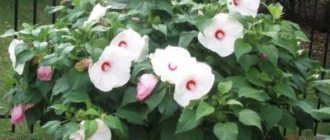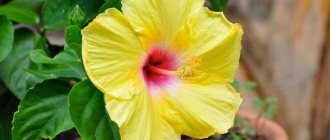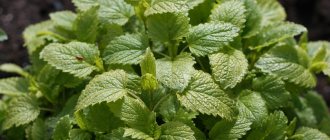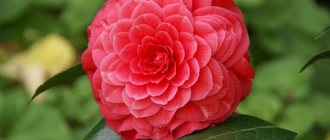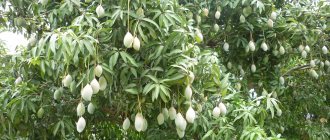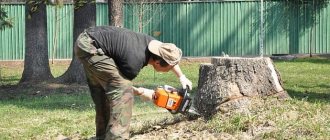Syrian hibiscus garden cultivation, care and video
The genus Hibiscus includes more than 220 species of deciduous or evergreen shrubs and herbaceous plants of the Malvaceae family.
The vast majority of species are native to warm tropical regions and are therefore cultivated as houseplants in temperate climates. Only two representatives of the genus are able to withstand frosty winters, and the most popular of them is the Syrian tree hibiscus - an ornamental shrub that does not require much time and effort to care for in the open ground.
The Syrian or garden hibiscus (Hibiscus syriacus) is native to the temperate subtropical regions of East Asia and is the official symbol of South Korea. In many countries it is often called the Rose of Sharon or the Syrian Rose.
Beneficial features
One of the beneficial properties of hibiscus is the ability to accumulate and absorb ultraviolet radiation, therefore its components are used in the manufacture of creams that protect against ultraviolet radiation.
Dried hibiscus sabdarifa leaves are added to the popular hibiscus tea. This reddish-ruby colored tea drink is high in vitamins C and PP, antioxidants and organic acids.
Red tea is useful for strengthening the walls of blood vessels and general blood circulation, it strengthens the immune system and restores blood pressure, and also reduces cholesterol levels. Tea can be served both hot and cold, complementing the taste with various spices and herbs. Hibiscus came to Russia from hot southern countries and was used for a long time as an antipyretic drink.
In countries located on the shores and islands of the Pacific Ocean, the Chinese rose is also common. The leaves of this plant are added to national dishes and salads.
Malaysian travelers bring banknotes and coins with hibiscus images as souvenirs. In the 70s of the 20th century, the Chinese rose was recognized as the flower of the nation of this country. Hibiscus is no less popular in Haiti. The flower is used in massage rituals and dishes. In India, wedding ceremonies are decorated with inflorescences.
Plants from the hibiscus family are directly related to Malvaceae. In natural areas they can be seen in Asian countries, in the European south of our continent, in Africa, America and even on the islands of Oceania. They are evergreen trees reaching a height of 2-3 meters. Some species are herbaceous or deciduous plants.
At home, the most striking representative is the Chinese rose. Photos and illustrations demonstrate the bright silhouette and grace of the flower. In countries with warm climates, where night temperatures do not fall below 18 degrees, hibiscus is grown in open ground.
In the temperate and subarctic zones, it is common in decorative floriculture in various subspecies: Chinese, Syrian, sabdarifa or otherwise Sudanese rose.
Description
Garden tree hibiscus grows quite slowly; in its natural environment it can reach a height of more than 3 meters and a width of 2.5 meters. In garden culture it is a low bush or standard tree from 1.5 to 2 meters in height.
The shoots are rigid, straight, poorly branched, covered with dark green jagged leaves that appear on the shoots in late spring.
A distinctive characteristic of many varieties of Syrian rose is their late flowering period - from late July to October. This feature and the exotic appearance of the flowers made the tree hibiscus a real pearl of the outgoing summer.
Large flowers are formed on the shoots of the current year and, depending on the variety, can be simple, semi-double, double, with wavy petals along the edge, single-color or two-color, often with a contrasting eye in the center.
The color is presented in a wide range of colors - snow-white, lilac, purple and all shades of red. The most valuable forms are lavender-blue and blue-blue in color.
Hibiscus - nice to meet you
Having already become a welcome guest from distant Southeast Asia, the hibiscus bush can delight us with its magnificent flowering for twenty years. In our country it is usually called Chinese and Sudanese rose, Chinese sorrel and African mallow, rosella and bukum - there are only three hundred species of this plant. Hawaiian women consider hibiscus their amulet, and Brazil can be proud of the original “princess earrings” - the hibiscus flower growing there looks very much like an earring.
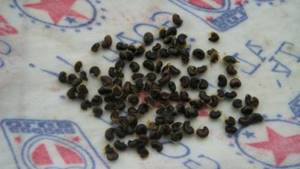
The buds of hibiscus inflorescences have many tones and shades, but in order to preserve the maternal characteristics, it is better to propagate it by cuttings. But grown from quality seeds and planted in the garden, a hibiscus bush can grow up to three meters in height and bloom all summer. The peculiarity of its five-petal flowers is their sequence: the opened bud remains on the branch for only one day, and the next one appears strictly according to schedule. Flowers sometimes reach a diameter of about 30 centimeters, but indoors everything looks much more modest.
Popular varieties of Syrian hibiscus with photos
"Pink giant" with very large dark pink flowers.
"Bluebird" - blue-violet flowers with a dark red center bloom from June to August. The growth is up to 15 cm per year.
"Joan of Arc" - snow-white double flowering lasts almost until November.
"Rosalba" - Large pink flowers with a red center look like they were cut from silk. Blooms from July to September.
“Red Heart” is a spectacular contrast of white petals and a red center. Flowering from July to late September.
“Pink Flirtation” attracts attention with very large purple-pink flowers with a burgundy center.
Delicate pink flowering of the Aphrodite variety.
Hibiscus "DUC de BRABANT" is an impressive variety with double, dark pink flowers.
Hibiscus variety 'Ardens' - large, double, lilac-pink and burgundy flowers - an impressive variety with large double lilac-pink flowers.
Another stunning double hibiscus is the 'Lady Stanley' variety, reminiscent of a peony with two-tone white and pink petals and a burgundy center.
Semi-double hibiscus Chiffon series, which includes several impressive varietal forms: “Blue Chiffon”, “Lavender Chiffon”, “Pink Chiffon”, “Chinese Chiffon” with red veins on the petals, “White Chiffon”.
"Marina" (syn. Blue Satin) is one of the valuable Syrian blue hibiscus.
There are forms with extremely decorative variegated leaves, such as "Purpureus Variegatus". The flowers of this variety are not very large and are only half open, so the flowering lasts longer than other varieties.
"Danica" - double flowers with red and pink spots on white petals. Flowering from late July until the first autumn frost.
Planting garden hibiscus
The best time to plant hibiscus is in the spring, when the soil warms up above 15 ̊C. Despite all its winter hardiness, the species is quite sensitive to severe frosts, so it takes time to take root and strengthen.
For the good development of the ornamental hibiscus shrub, it is extremely important to choose the right place, which should be warm, sunny and protected from the wind.
Like roses, the crop grows well in permeable, sandy loam soils with a high humus content. Soil reaction is neutral to slightly alkaline.
Before planting the seedling, dig a hole 2 times wider than the size of the root ball. The distance from buildings and other plantings should be at least 1-1.5 meters.
Variety “Pink Chiffon”
At the bottom of the pit, lay out a 15-centimeter drainage layer of broken brick or crushed stone, then the same layer of coarse sand, which is sprinkled with compost mixed with soil. Place the roots in the hole and cover with a pre-prepared soil mixture of the top layer of soil, compost, sand and peat, taken in proportions 2: 3: 2: 1.
If the soil is initially enriched with sand, then a drainage sand layer is not needed. The root collar after planting should be slightly below ground level. The seedling is well watered with about 7-10 liters of water.
Immediately after planting your garden hibiscus, you should cut all shoots in half. This procedure, reluctantly performed by gardeners, is aimed at forming a dense and lush crown, as it stimulates the growth of new shoots.
The plant grows in one place for about 20 years, so hibiscus is transplanted only when absolutely necessary and only for young specimens.
Features of caring for Syrian hibiscus
The Syrian rose is unpretentious in care; it is enough to follow a few growing rules so that the green pet will delight you with magnificent blooms every season.
Variety "Marina"
Gardeners recommend laying a thick layer of pine bark mulch around the plantings. Mulching helps protect roots from freezing, reduces moisture evaporation and controls weed growth.
Tree hibiscus requires a constantly moderately moist substrate without stagnant water. Watering is carried out regularly, not allowing the soil to dry out. However, do not overdo it, as over-irrigation causes root rot to develop.
To avoid problems, the topsoil should dry out between irrigations. Deep watering once a week in the absence of heavy rain will be sufficient. In dry and hot summers, water once every 1-2 days. Keep an eye on flowering - too little or too much water can cause flower buds and buds to fall off.
After watering in the summer, so that the soil does not form a crust, loosen it. The procedure gives oxygen access to the root system of the plant. Caring for tree hibiscus also includes regular removal of faded flowers, which stimulates longer and more intense flowering.
Possible pests and diseases of hibiscus
Hibiscus is characterized by patience and endurance. Minor flaws in growing conditions may go unnoticed if they are not repeated systematically.
- The main danger for shrubs is dry soil, dry air and drafts. The plant will lose its buds and then its leaves.
Solution: regularly water the bush, spray it if the air is dry, protect it from drafts, and do not expose it to unexpected temperature changes. Feeding is also important. Often, the bush quickly gets rid of any external signs of the disease.
- Aphid. An insect that is attracted to hibiscus by still immature leaves and buds. Aphids multiply at high speed and as a result you will have to fight entire colonies of pests.
Solution: treat the plant with any special preparation.
- Spider mite. Another name is red spider. This insect is very small and is noticeable only with significant magnification. As a rule, it lives under the leaves of the plant and in a thin web. The optimal environment for reproduction is warm and dry air.
Solution: thoroughly wash the bush with soapy water, then frequently spray the leaves or wash in the shower.
How garden hibiscus overwinters
Preparing hibiscus for winter is an important plant care process. Syrian rose is one of the most frost-resistant species. However, young seedlings, especially those planted in autumn, and some double varieties are most sensitive to low temperatures.
With the onset of frosts down to minus 3-4 ̊C, the root space of the bush is insulated with a thick layer of fallen leaves and spruce branches. From above, the ground part is covered with agrofibre or sackcloth, and spruce branches are applied.
Adult specimens in a sunny, wind-protected place can easily withstand frosts down to minus 15 -20 °C, but in snowless and severe winters it is also recommended to spud them and insulate them.
Make sure that the plantings do not rot at the end of winter - as soon as the danger of freezing has passed and severe frosts have subsided, the covering from the bush and around the roots can be removed. In the northern regions, the crop is grown in pots and brought into a cool room with the onset of frost.
Growing Hibiscus
The Chinese rose is unpretentious, but needs careful watering and good lighting. If you put a little more effort and time into care: trim the Chinese rose in a timely manner and regularly spray it, you can get a stunningly beautiful miniature tree in your apartment.
The focal point of hibiscus is the flowers. They are rich in color and quite large, although they bloom for only two to three days. The Chinese rose will need a large pot as the plant is quite large in size.
Temperature, lighting
It is advisable to maintain the room temperature at +21...+26°C in summer and +15..+20°C in winter. In the cold season, there is no need to lower it greatly, since the plant will easily survive the winter in a warm place, but will develop better in a cooler room.

Although hibiscus loves the sun, you should not leave it in the rays for a long time, as it can get burned, as a result the leaves will wither and fall off. It is best to choose a place where diffused light will fall on the rose. In summer you need to take it out onto the balcony or loggia. It is worth considering that it does not tolerate drafts and strong winds, and also needs abundant watering in spring and summer (it can be reduced in winter). The leaves should be sprayed daily in the morning and evening.
Soil, fertilizers
The plant is not particularly demanding on the soil; it is enough to mix plain soil with coarse sand and humus. Mix the mixture and plant the hibiscus in a pot, put foam balls or another type of drainage.
The transplant will not be needed soon: when the Chinese rose has taken root well and begins to grow actively. With each new relocation, the flower will need a larger pot, and best of all, a flowerpot.
In the spring, you can fertilize with special mineral fertilizers that contain copper and iron chelate. Hibiscus benefits from spraying with added minerals and growth solutions to the water.
Pruning garden hibiscus
Sanitary pruning is carried out annually in the spring. Remove dried, broken and frost-damaged shoots. If the bush is too thick, thin it out slightly to ensure even sunlight and improve air circulation.
Branches with signs of disease are removed and immediately burned. If the ground part is completely frozen, then radical pruning is carried out. Soon you will see new shoots growing from the roots.
It is recommended to carry out formative pruning of hibiscus in autumn or spring. Last year's shoots are shortened by a third evenly or left at different lengths to obtain a more luxuriant shape.
To form a standard hibiscus, one medium strong shoot is selected from a young plant, and the remaining branches are shortened to 2-3 buds.
Each subsequent year, at the beginning of spring, the lateral growing shoots are constantly shortened to 1 lower bud, allowing only the middle shoot to develop, the apical branches of which are cut off to give the shape of a sphere.
It should be noted that pruning hibiscus in the fall shortly before winter allows you to get larger, but not as numerous flowers. Although the spring procedure stimulates abundant flowering, the flowers themselves are formed of medium size.
Syrian rose is an excellent shrub for shaped hedges. Pruning for these purposes is carried out in the spring, giving the plantings a rounded shape.
Reproduction of hibiscus tree
The culture is propagated by seeds, cuttings and layering.
Propagation of garden hibiscus by seeds
Many varieties of tree-like Syrian hibiscus are easily propagated by self-sowing, so you can often find small seedlings under the bushes that sprout from fallen seeds. They can be carefully dug up with part of the soil and transplanted to a new location.
You can also sow the seeds yourself directly in open ground in a warm, sunny place. Before sowing at the end of April, the seeds are kept overnight in a weak solution of potassium permanganate or simply in water. After sowing, water and cover with film, which is periodically removed for ventilation.
When sowing before winter, the crops are covered with spruce branches or fallen leaves. For information, hibiscus grown from seeds does not replicate the varietal qualities of the mother plant.
Propagation of tree hibiscus by cuttings and layering
Green semi-lignified cuttings 15-17 cm long are cut in the summer just below the leaf node, the lower leaves are torn off. A cut of cuttings is dipped in a special root-forming hormone, after which it is buried in a mixture of peat and perlite (2:1), watered and covered with a transparent bag.
Rooting usually takes about a month, provided the temperature in the greenhouse is 21-23 ̊C. Keep the soil moderately moist and periodically remove the bag for ventilation.
When growth begins, the cover is removed, and after another month, the stronger seedlings are pinched and transplanted into open ground. Monitor soil moisture throughout the season. If your seedling has bloomed, it is better to remove the flower so that it does not weaken the plant.
Some gardeners recommend transplanting rooted seedlings into pots with fertile substrate and leaving them in a cool room for the winter, and planting them in the ground in the spring in May.
Attention! Some varieties, for example, "Ardens" actively develop roots after rooting, but the above-ground part does not show signs of growth until the next season. Old leaves will fall off in early spring, and new leaves will appear from the internodes.
Video
Before wintering, young and tender plants should be well protected from frost by covering them with a thick layer of fallen leaves or spruce branches. Flowering can be expected in the first or second year of cultivation. Plants reach a height of 1.5-2 m in five to seven years.
In order to obtain a new seedling using layering, in mid-March the side shoot is tilted and secured with wire staples to the ground in a pre-dug trench 2-3 cm deep.
Cover with soil and keep it constantly moist for a month to speed up the formation of roots. When you see new growth, reduce watering. Layers for transplantation are separated from the bush in the fall or next spring.
Problems in care
With proper care and cultivation of tree hibiscus, the crop is quite resistant to diseases and pests. However, increased air humidity can lead to the development of powdery mildew or fungal leaf spot, which appears as brown spots.
Gray mold also occurs due to high humidity, causing flower buds to rot, leaves to wither and fall off, and shoots to die. Diseases are treated with fungicidal drugs. For prevention, water the plantings in the morning and only at the roots, make sure there is good air circulation around the bushes.
Infection with a rust fungus, which causes yellowing and mottled leaves, is also possible. The disease is characterized by yellow-orange pustules on the lower surface of the leaf. Affected leaves are removed and burned.
Quite rarely, a plant can be attacked by spider mites and aphids.
Choosing an effective propagation method
The choice of propagation method depends on the type of hibiscus and the time of year.
Optimal time
A plant should be propagated when it:
- Absolutely great.
- The branch is bent towards the soil, which creates the possibility of division by layering.
- It has grown so much that you can cut off one cutting.
Hibiscus is propagated in spring and summer; if the flower is damaged by pests or is sick, then division should be postponed until the plant recovers.
Hibiscus is propagated using the following methods:
Cuttings
Can be used all year round, but best in spring and summer. Before pruning, the mother plant should be watered and pruned thoroughly. Along with the withered and limp shoots, cut off the cuttings (branches with a thick green stem and the presence of two internodes). Pick off all the leaves from this shoot and root the flower.
Layerings
No more difficult than the first method. To divide the bush, choose regular, air or vertical layering, the first is best. Sprinkle the selected branch with soil and leave the top open. In a place sprinkled with soil, roots will soon begin to grow. Before propagation, you need to prepare the soil: it must be well moistened, have high air permeability, and drainage is required. The branch that needs to be bent, cleared of leaves and placed in a dug hole in a flowerpot, if necessary, secured with wire so that it does not bend back. This method is applicable in the spring. Already in the fall, you can separate the shoot from the mother plant into a separate pot.
Seeds
The most uncommon and complex method. Moreover, all varietal characteristics of hibiscus are lost. The procedure is as follows:
- soak the seeds in water with growth stimulants;
- put them in a wet gauze cloth and then in a plastic bag for three days, until roots take root;
- plant in a pot with soil and humus;
- Do not deepen the seeds too much and cover the pot with a bag for thermal effect, after 2 weeks remove everything;
- Water moderately and after 3 months transplant the young hibiscus into a larger container.
Dividing the bush
Used in spring and summer. Secateurs, a knife and a spatula must be treated with a disinfectant and the bush must be dug up. Next, clean the root system from the soil, being careful not to damage it. Using a treated knife, cut off 2-3 stems with roots. Afterwards, plant each separated shoot in its own pot, where soil with humus is poured. New flowers should be watered often, but in moderation.
How to root
There are only two ways to root a Chinese rose.
In soil:
- Before planting in the ground, you need to wait until the cuttings give their own roots, lower them into a small glass with soil and sand, before dipping each shoot in a heteroauxin solution.
- After planting, lightly compact the soil at the base; the cuttings take root after a month.
- Build a small greenhouse around the plant in the form of a bag or a piece of glass to keep it warm and humid inside.
In water:
- Use a dark glass glass and pour warm water into it.
- Add a few tablets of activated carbon and a growth stimulator.
- Place the glass in a well-lit place, but out of direct rays.
- Plant in a pot only after the plant produces two or three leaves and the roots reach 5-7 centimeters in length.
Possible problems and difficulties after division
New shoots need to be watered daily, monitored for high humidity and moderate temperatures. If a young red rose is not provided with proper care, it will quickly shed its leaves and begin to wither. To avoid the appearance of mites and aphids, it is advisable to wash the plant with soapy water and wipe with a wet cloth in the shower. If the leaves turn yellow, you need to reconsider the applied mineral fertilizers - add nitrogen and iron and reduce chlorine and calcium.
Garden hibiscus
Hibiscus, a flower that many gardeners strongly associate with the Chinese rose houseplant. Having seen lush bushes in the garden plot, densely dotted with huge “gramophone pipes” of bright red, orange, crimson, etc. colors, it becomes a revelation for them that this is also a hibiscus. But garden hibiscus is not so exotic. It has long been successfully grown by amateur flower growers. At the same time, it is growing successfully both in Crimea and in the Moscow region. And caring for garden hibiscus is not difficult. In any case, it is no more difficult than caring for roses, yuccas or clematis.
About the plant
Without going into special botanical details, I note that in the amateur community, garden hibiscus is divided into two types - “ tree-like ” and “ herbaceous ”. This division is very conditional. In fact, each of these types has many independent species, subspecies and varieties. All hibiscus belong to the malvaceae family. The “ancestor” of this family, mallow, is very well known to almost everyone, including beginner flower growers. By the way. The flowers of most types of garden hibiscus and hollyhock are strikingly similar. There are quite a few types of hibiscus. But as usual, not all of them can grow outside their natural habitat. And for this plant these are the tropical and subtropical zones of both hemispheres. In temperate latitudes, mainly Syrian Hibiscus and Trifoliate Hibiscus grow. But the breeders did not sit idly by. They bred Hybrid Hibiscus. It is this hybrid species, with its numerous varieties, that is classified as herbaceous hibiscus. Of the tree species, the most beloved and widespread is G. Syrian. This perennial, deciduous plant is successfully grown as an ordinary shrub, but with not much effort, it can be turned into an original standard tree.
By the way. Called Syrian, this hibiscus is actually Chinese in origin. It also grows in Korea and some other countries in Western Asia. But it has nothing to do with Syria. It does not grow there in natural conditions.
All varieties of tree hibiscus are perennials, but herbaceous hibiscus also has annual varieties. The flowers of all species and varieties of this plant, without exception, stand out for their considerable size and beauty. Their colors may vary depending on the variety. From white to lilac and purple. Also, their appearance can be either simple or terry. But what can be said with confidence is that there are no ugly garden hibiscus! And in order for this beauty to delight you every year and for a long time, you need to work a little.
How to care for hibiscus at home
Even in Ancient Greece, hibiscus was well known. However, this was the name of another plant. The Greeks believed that hibiscus was a stockrose native to the Mediterranean. Nowadays, hollyhock is better known as mallow. As for hibiscus, its name, well known today, is Chinese rose.
The most revered and famous hibiscus is on the islands located in the Pacific Ocean, its southern part.
Many local residents enjoy decorating their hair with bright, large flowers. Even translated, the name of the plant means “flower for beautiful ladies.”
This exotic beauty represents one of the five national flowers of Malaysia. Petals are symbols of the commandments of Islam. However, hibiscus is held in high esteem not only by Malaysians, but also by residents of China and India.
In the East, it is believed that the Chinese rose is the guardian of the family hearth, patronizes business people, radiates energy and suppresses depression.
The plant was widely used in the production of dyes, ropes, and medicines.
Landing
Where and when to plant
All types of garden hibiscus will feel great in a well-lit place. The more sun the better. But at the same time, the place where it will grow must be protected from the wind. When choosing a place, be sure to keep in mind that you are choosing it for a long time. Garden hibiscus is a long-lived flower. In one place, without renewal, it will live for 20, or even more years. The composition of the soil for herbaceous species is not considered particularly important; they can also grow on loam. There are only two conditions - the soil should not be calcareous and should not become waterlogged. He doesn't like being overwatered. Light and fertile soil is preferred for Syrian hibiscus. Most often they are planted together with roses. What suits a rose also suits a tree hibiscus. And it looks beautiful and harmonious in the rose garden.
Advice. If your winters are frosty, then preference should be given to herbaceous varieties with simple, non-double flowers. They were specially bred to be frost-resistant.
The most favorable time for planting garden hibiscus is spring. But you need to wait for stable warmth, and only then plant. By the coming winter, the plant will have become strong enough during the warm season to successfully overwinter.
Caring for garden hibiscus

Growing Hibiscus
In addition to watering, which may not be necessary, caring for hibiscus will consist of regularly loosening the soil, fighting weeds, and removing dried shoots and faded flowers. As for the latter, you will have to do this daily. Garden hibiscus generally blooms profusely and for a long time, but the life of each individual flower is short - only a day. Therefore, they must be removed regularly, and the next ones will immediately appear next to them.
For the winter, especially if you have a first-year plant or severe winters, cover it. Hibiscus shelters for the winter, just like roses
Watering
Hibiscus does not need frequent watering. Moreover, they can cause irreparable harm to him. Therefore, it is necessary to water only after the soil dries. Usually natural precipitation is sufficient and there is no need for watering. But if the summer is hot and dry, then you will have to water often.
Top dressing
The period of active life of hibiscus lasts all summer, from June to September. During this period, feed it twice a month with flower fertilizers with a high content of nitrogen and phosphorus. With the onset of autumn, when preparations for wintering begin, give preference to potash fertilizers. A tincture of ordinary wood ash or ashes has proven itself well in this capacity. It can even be added to water for irrigation.
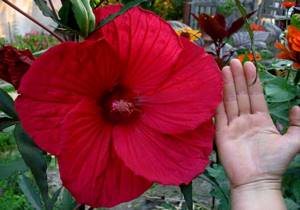
Hibiscus pruning
Herbaceous varieties of garden hibiscus do not need pruning as such. Unless before winter, remove all dried stems (and this is the entire above-ground part). But the tree-like species, in particular the Syrian hibiscus, needs regular, thorough pruning.
Conventionally, they can be divided into three types: hygienic, stimulating and formative trimmings.
Hygienic pruning of hibiscus is a mandatory event and is carried out in early spring, when sap flow has not yet begun. First of all, you need to remove all the dried and frozen branches over the winter. Also remove branches growing inside the plant. Thoroughly prune weak branches or, on the contrary, overdeveloped branches that do not have lateral growths. Remove all root shoots; you don’t need them.
Stimulating pruning of hibiscus is carried out simultaneously with hygienic pruning and is also mandatory. The fact is that Syrian hibiscus produces flowers only on young shoots. Therefore, the more of them there are, the more abundantly the hibiscus will bloom. To increase the growth of young branches, it is enough to shorten the old ones by a third of their length.
Formative pruning is not necessary for garden hibiscus. You rather need it. Well, since in the spring you still have to trim it, then why not give it a shape at the same time? Moreover, Syrian hibiscus is an ideal plant for formation. Showing your imagination, over time you can give it any shape and create a small topiary.
Replanting garden hibiscus
There is no particular need for replanting this plant. Unless you made a mistake in choosing the location or the plant was flooded and the roots rotted. In herbaceous, hybrid hibiscus, replanting is combined with division of the rhizome, for which it is most often started. But if the need for replanting arises, then it is carried out at the same time as the initial planting, but before flowering begins. The transplantation technology is the same as for planting.
Hibiscus propagation
Hybrid varieties are easiest to propagate by dividing the rhizomes, and tree-like varieties are propagated by cuttings. But there are ways to propagate hibiscus also by seeds, layering, and grafting.
Hibiscus from seeds
This method of reproduction is not at all complicated. Obtaining healthy hibiscus seedlings suitable for planting in open ground is no more difficult than growing ordinary seedlings.
You can start sowing seeds as early as January (to March). The seeds themselves must be fresh, this will increase the percentage of similarity. It is advisable to prepare them first by soaking them for 20-30 minutes in a pink solution of potassium permanganate. After this, place them for a day in a solution of any stimulant (epin, heteroauxin, kornevin, etc.). The mixture for planting hibiscus seeds should be very light. It can be made by mixing peat with sand, or even better, with perlite or vermiculite. To germinate seeds, a stable temperature within +25-26 degrees is required. Ideal if you can provide bottom heating. The top of the container with the planted seeds is covered with glass or film. During the germination process, you need to monitor the soil moisture, periodically ventilate and wipe off condensation from the glass (film). When the shoots appear, they need to be provided with good lighting. Otherwise, they will become thinner and stretch out. When the leaves of the seedlings are well developed, they can be planted separately. When the weather is warm outside (usually mid-to-late May), young hibiscus can be planted in open ground.
Propagation of hibiscus by cuttings
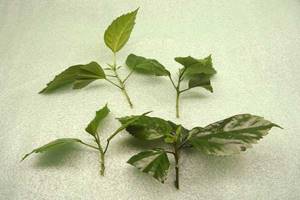
This method is very simple. Cuttings are taken in summer. There is no need to take too big. It is enough if the hibiscus cuttings have two to three internodes. Next, after treating the cut of the cutting with a stimulant (preferably, but not necessary), it can be planted in light soil and covered with a transparent cap. This is approximately how Decembrist cuttings take root. Usually within a month the cuttings have acquired their own roots and are ready for transplanting. It is transplanted into a regular flower pot with a light earthen mixture. Example of a mixture: equal parts of turf soil, peat and sand. After this, garden hibiscus becomes a houseplant until spring. In spring it is planted in open ground.
You can simplify the task by simply placing the cuttings in a container with water (like cuttings of zebrina, geranium, monstera, ficus benjamina, etc.), and after the roots appear, plant them in a pot. Although in this case an intermediate operation is added, the process of growing roots will take place before your eyes and will relieve you of unnecessary worries. Propagation of hibiscus by cuttings is more interesting because the seedlings, by the time they are planted in the ground, are stronger and often bloom this year.
Possible difficulties during cultivation
Pests
The most harmful pests that can attack garden hibiscus are aphids and spider mites. That is, the same parasites that attack roses. But if you plant lavender near it, and plant geranium nearby in the summer, it will not only be beautiful, but will also repel aphids. If this doesn’t help much or you don’t have such plants, then you can use these tips. Spider mites are a little more difficult to fight. The methods of combating it on garden flowers are almost the same as on indoor plants (read how).
In addition to aphids and mites, you can expect thrips and whiteflies. There are many systemic drugs against them.
Diseases
If you care for garden hibiscus correctly, then diseases will disappear. Most often, gardeners have to deal with chlorosis. But this is most likely not even a disease, but rather a plant reaction to a lack of iron and nitrogen. With chlorosis, hibiscus leaves, starting from the bottom, turn yellow and fall off, and young leaves initially appear veined with a yellow tint. To avoid this, do not ignore feeding the plant. But if signs of chlorosis appear, then start additional fertilizing with iron chelate. Moreover, it is carried out both at the root and “over the leaf”, by spraying. Doses and frequency are usually described in detail in the instructions for the drug.
Hibiscus leaves turn yellow not only due to chlorosis. The reason for this may also be dry soil. It is enough to increase watering and everything will return to normal. Also, yellowing of hibiscus leaves can be a consequence of injury to the roots (for example, during replanting or careless loosening of the soil). In this case, the roots need to be strengthened by adding a little root formation stimulator (“Kornevin” works well) to the water when watering. It is advisable to spray the leaves with the same solution.
Caring for a Chinese rose or how to achieve long-term flowering?
The plant loves a bright place, protected from direct sunlight. Hibiscus will not bloom in the shade. In the warm season, it feels great outdoors, so the bush can be placed on the balcony or in the garden. A place for this should be chosen that is protected from the scorching sun and drafts.
Air temperature and humidity
In summer, the hibiscus plant grows and blooms well at air temperatures from +18 to +25 degrees. In winter, the temperature should not be lower than +15 degrees, but home roses cannot tolerate heat either. At low temperatures, the plant may begin to shed its leaves.
Chinese rose loves high air humidity. Therefore, during hot periods and in winter, when the heating is on, hibiscus leaves must be sprayed regularly. Once a month, and if possible more often, it is recommended to bathe the bush under a warm shower. During this procedure, dust and possible pests (for example, spider mites) will be washed off the leaves, and the plant itself will be saturated with a sufficient amount of moisture. A pot of soil should be wrapped in cellophane before bathing.
Chinese rose - watering and fertilizing
Hibiscus love abundant watering, especially during flowering and active growth. But they should be watered only after the top layer of soil has dried. Constant waterlogging of the soil can lead to the development of fungal diseases and root rotting. Insufficient watering, especially in hot weather, domestic Chinese roses do not tolerate well and begin to shed leaves and buds.
The plant should be fed from March until the end of flowering. To do this, you can use the following complex fertilizers:
During the period of budding and flowering, the bushes should be fed every two weeks with fertilizers with an increased dose of potassium and phosphorus.
Fertilizers should be applied only after watering the soil, otherwise the roots of the plant may receive a chemical burn.
Hibiscus - replanting and pruning
Young plants are transplanted into larger diameter pots annually. Adult bushes should be replanted only after the root system becomes crowded in the old flowerpot. For replanting, you can buy special soil at a flower shop or prepare a mixture of the following components:
· peat soil – 1 part;
· humus – 0.5 parts;
· leaf soil – 1 part;
· turf soil – 1 part;
· sand – 0.5 parts.
Drainage (expanded clay, clay cuttings or broken brick) should be placed at the bottom of the pot.
Many people do not know how to transplant a Chinese rose without damaging the roots. To do this, it is recommended to use the transshipment method. Having carefully taken out the bush from the old pot, it is transferred and placed in a new pot prepared in advance.
When and how to prune a Chinese rose
- one of the main questions for beginning flower growers. The purpose of pruning is to form a lush bush and increase the number of flowering shoots. Therefore, pruning is done before transplanting the plant in the spring:
1. Bare, elongated and dried shoots are removed.
2. Healthy branches are shortened by half.
3. To prevent juice from leaking from the wounds, the cut areas are treated with garden varnish.
4. When rejuvenating an adult bush, all branches are cut to 15 cm. In this case, at least one bud should remain on the shoot.
5. When new shoots begin to grow, weak ones must be removed.
6. In summer, the bush is pruned again. As a result, buds will appear on the old but renewed plant in the fall, and it will delight you with its flowering until spring.
toNature.info
Hibiscus, which came to us from eastern countries, has gained incredible popularity in our regions. It's not strange! The beauty of this plant attracts the eye and touches our heart! You can often hear an alternative name for this plant - Chinese rose.
This plant is grown both at home and in open ground conditions, for example, in a garden or greenhouse. Hibiscus prefers a warm atmosphere. If your region does not have warm weather, then the best option would be to grow this flower at home, otherwise it will not survive. If your region has only rare temperature changes - dropping to a significantly low level in winter - you need to plant the hibiscus outside in a large pot, and then move it indoors for the winter so that the plant warms up.
In order for hibiscus to develop well, you need to use a certain type of soil - rich in humus and fertile, loose. You need to choose a place that is well lit, with sufficient sunlight. It is necessary to water the hibiscus regularly, waiting until the top layer of soil dries, so as not to flood the roots. If the roots are constantly exposed to excessive moisture, then after some time the hibiscus will stop blooming, growing and developing, and then you will notice a deterioration in the condition of the plant, then possible death. If you provide proper care for the plant and constant monitoring of its health, hibiscus will delight you with constant flowering and systematic development, and its life expectancy will generally be about 20 years.
Hibiscus blooms from spring to autumn. The flower grows quite quickly. This is especially evident in conditions close to ideal. That is, those that you and I have already learned: good lighting, absence of frost, sudden temperature fluctuations, changes in light and shadow lighting, absence of drafts and other factors that disrupt the normal living conditions of hibiscus.

There is a special ritual that helps the plant grow better - replanting. Hibiscus should be replanted according to plan, before the flowering period - in early spring. According to the advice of flower growers, such intervention significantly accelerates the further growth of hibiscus, as well as its flowering. After transplanting into new soil, new buds appear, and then inflorescences, which then bloom and delight you with huge and bright flowers. In addition, the crown of the plant also increases and grows in volume. You will notice that the hibiscus has become more attractive and healthy in appearance. Also, when caring for hibiscus, do not forget about pruning, which also activates the growth of the plant. You need to trim off inactive flower stalks, as well as dried branches. The branches are cut to half the available length. It is advisable to distinguish between the process of replanting and pruning the plant, because both processes are very stressful for hibiscus, as well as for any other plant, so consider whether your hibiscus needs one or the other if yes, then feel free to implement it!
Please rate the material you read :)
( 5 rated, score: 8.00 out of 10)
Chinese rose - propagation
Shrubs can be propagated in three ways:
How to grow hibiscus from seeds?
It is necessary to prepare for sowing seeds in February. The seeds are pre-soaked in a weak solution of potassium permanganate or for 10 hours in Epin. Sowing is done in universal soil or peat-sand mixture purchased at a flower shop. The seeding depth is 1-1.5 cm. The soil is carefully sprayed and the container is covered with film or glass. It turns out to be a mini-greenhouse, which is placed in a warm place. Plantings are ventilated daily and, if necessary, moistened.
At temperatures of +25-+27 degrees, seedlings can appear within three days. The container with the sprouted seedlings is placed in a bright place, protected from direct sunlight. Young plants with two or three true leaves are planted in separate pots.
A Chinese rose grown from seeds may not retain the varietal characteristics of the mother plant. The shrub will bloom 3-4 years after planting.
Propagation of Chinese roses by cuttings
Rooting cuttings is the fastest way to propagate hibiscus. For rooting, it is recommended to use apical cuttings 15 cm long. The lower leaves are removed from the cut branch. On varietal plants, the leaves are usually large, so the remaining 4-6 apical leaves are cut in half. This is necessary to reduce moisture evaporation.
The lower part of the cuttings is dipped in Ukorenit or Kornevin, which are root formation stimulants. Rooting can be done in a peat-sand mixture, water, peat tablets, perlite.
The seedlings are covered with bags or placed in a mini-greenhouse. When roots appear, they are transplanted into a soil mixture consisting of turf soil, humus and sand (1:2:1). Since hibiscus does not tolerate stagnant moisture, the bottom of the container is covered with drainage.
To prevent young bushes from stretching out, but bushing, the shoots need to be pinched. With proper care and favorable growing conditions, the shrub can bloom this year.
Cuttings are only suitable for ordinary varieties of Chinese rose. Hibiscus of Indian, Taiwanese, Florida and Dutch selection are propagated only by rootstock. Rosean is used as it.
Problems when growing Chinese roses
To properly care for hibiscus, you need to know what this plant does not like:
· direct sunlight, which will burn the leaves;
watering with cold water;
· damage to the root system during transplantation;
· keeping plants during the dormant period at elevated temperatures.
When the air temperature is low, the soil is dry and there is a lack of nutrients, the buds may fall off.
Uneven yellowing of leaves or chlorosis occurs when the root system rots, lack of iron and nitrogen, and increased levels of calcium and chlorine salts in the water.
If there are a lot of beautiful green leaves on the bush, but no buds, then this indicates a lack of lighting or an excess of nitrogen in the soil.
Diseases of Chinese rose (hibiscus)
To keep a Chinese rose healthy, you don’t need to put in a lot of effort, but it still requires proper care. If a flower has a lot of green leaves, then it may not bloom. The reason lies in excess nitrogen fertilizers, insufficient light or watering.

When yellow leaves appear, we can safely say that the plant does not have enough sunlight. In addition, the red rose is affected by larvae and pests. Most often these are spider mites and aphids; they appear in autumn and winter due to wet or dry soil, drafts, and inappropriate care. Pest control is simple: spray with insecticides and wipe with soapy water.

